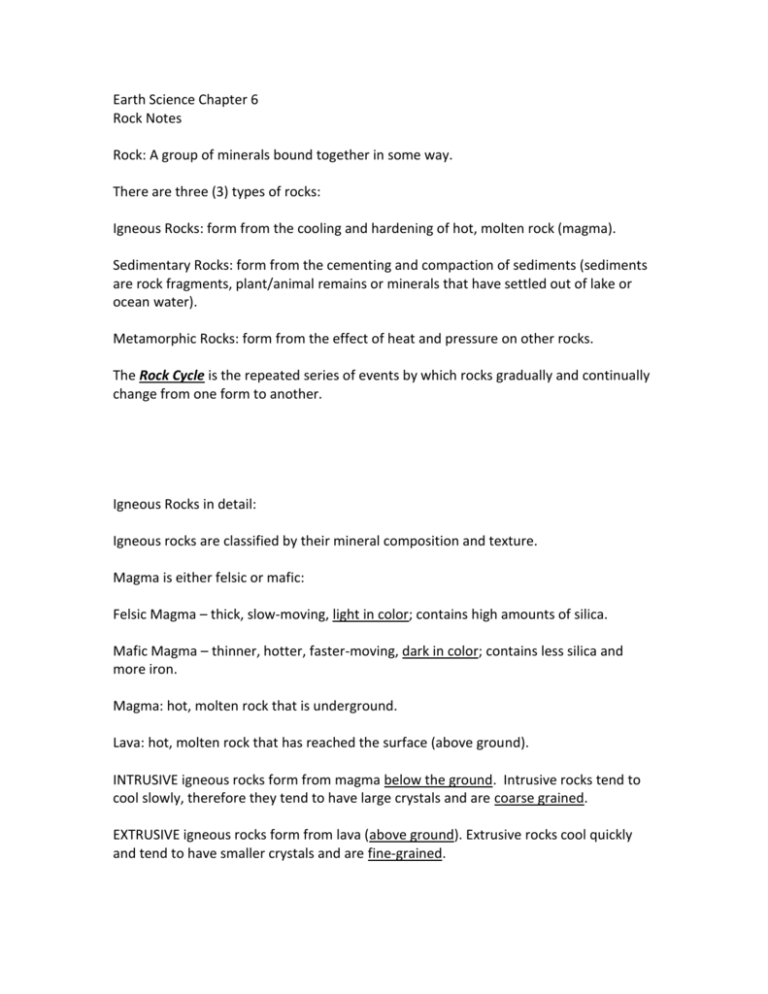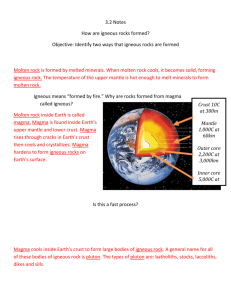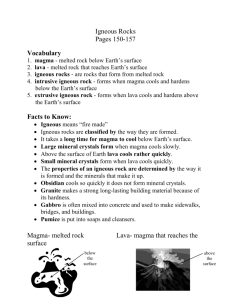Earth Science Chapter 6
advertisement

Earth Science Chapter 6 Rock Notes Rock: A group of minerals bound together in some way. There are three (3) types of rocks: Igneous Rocks: form from the cooling and hardening of hot, molten rock (magma). Sedimentary Rocks: form from the cementing and compaction of sediments (sediments are rock fragments, plant/animal remains or minerals that have settled out of lake or ocean water). Metamorphic Rocks: form from the effect of heat and pressure on other rocks. The Rock Cycle is the repeated series of events by which rocks gradually and continually change from one form to another. Igneous Rocks in detail: Igneous rocks are classified by their mineral composition and texture. Magma is either felsic or mafic: Felsic Magma – thick, slow-moving, light in color; contains high amounts of silica. Mafic Magma – thinner, hotter, faster-moving, dark in color; contains less silica and more iron. Magma: hot, molten rock that is underground. Lava: hot, molten rock that has reached the surface (above ground). INTRUSIVE igneous rocks form from magma below the ground. Intrusive rocks tend to cool slowly, therefore they tend to have large crystals and are coarse grained. EXTRUSIVE igneous rocks form from lava (above ground). Extrusive rocks cool quickly and tend to have smaller crystals and are fine-grained. Families of Igneous Rocks: Granite: Felsic, light in color, coarse-grained. Includes: granite, pumice, rhyolite, and obsidian. Gabbro: mafic, dark in color, dense. Includes: gabbro, basalt, diabase, and scoria. Igneous Intrusions: a rock mass that forms when magma cools inside of Earth’s interior, also known as “plutons”. Plutons include sills, laccoliths, batholiths, dikes, and volcanic necks. Batholiths are the largest of all igneous intrusions. Igneous Rocks Sills, Dykes Stocks and Batholiths image adapted from www.brocku.ca/earthsciences/people/Simon/1f90dial.jpg The above diagram illustrates several different igneous structures: A Stock G Volcanic Pipe B Batholith H Composite Volcano C Laccolith I Lava Flow D Magma J Cinder Cone E Dyke K Volcanic Neck F Sill The main intrusion is the batholith, a large mass of magma which has intruded/ replaced a large amount of another rock. They are over 100 km wide and normally form in areas where mountain building is in action. Stocks are bulges on the tops of batholiths. Sills and dykes are formed when magma intrudes into rock. Sills form where magma intrudes between layers, they run parallel to the layer. Dykes form when magma intrudes into a rock along lines of weakness such as fractures and fissures. Dykes cut beds and range in size from a few cm to several km. http://www.chm.bris.ac.uk/webprojects2002/spence/page3a.htm








